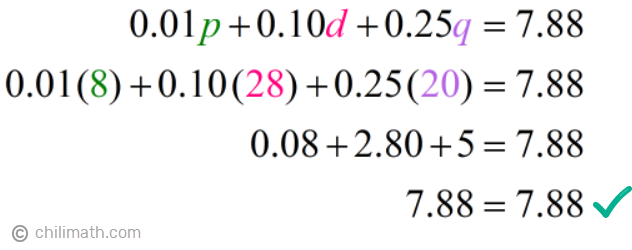Coin Word Problems
The secret to success in solving coin word problems is to be able to set up the correct systems of equations and precisely solve it using the substitution method or at times, the elimination method.
It’s also worth pointing out that the presentation of the algebraic expressions in coin word problems are a bit different and not so straightforward compared to what we’re used to. For example, instead of saying “the number of nickels is 2 more than the number of dimes“, you’ll often see this expressed in coin word problems as “there are 2 more nickels than dimes“. Both algebraic expressions can be written in an equation as [latex]n=d+2[/latex] but just expressed differently.
Therefore, it is crucial to have a keen eye and understanding of the information given in a coin word problem so we can translate the algebraic expressions correctly into equations. More importantly, you must be familiar with the value of each kind of US coin.
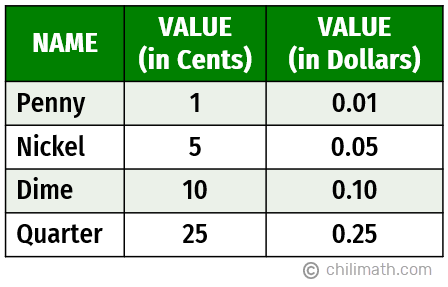
Note: In solving our problems below, we will use the value of the coins in dollars which are listed under the third column in the table above. As you can see, the penny has a value of 0.01, the nickel has a value of 0.05, the dime has a value of 0.10, and the quarter has a value of 0.25.
Example 1: Tamara has 35 coins in nickels and quarters. In all, she has $4.15. How many of each kind of coin does she have?
Right off the bat, the problem gives us two important pieces of information. First, it tells us that there is a total number of 35 coins consisting of nickels and quarters. Secondly, the total value of the coins is $4.15. We need to translate these statements into algebraic equations to find how many nickels and how many quarters she has.
Coin word problems usually involve two types of equations. One equation describes the total number of coins while the other describes the total amount of money.
But before we start writing our equations, let’s select variables that will stand for the unknown values in our problem.
- Let [latex]n[/latex] = number of nickels
- Let [latex]q[/latex] = number of quarters
Now that we have our variables, let’s write the two statements into equations.
1) Tamara has 35 coins in nickels and quarters.
Equation #1: [latex]n + q = 35[/latex]
2) In all, she has $4.15.
Equation #2: [latex]0.05n + 0.25q = 4.15[/latex]
Note that in Equation #2, we multiplied the value of each coin (in dollars) by how many of that specific coin we have. So, since nickel is worth 5 cents, we multiplied 0.05 by the number of nickels ([latex]n[/latex]) and multiplied 0.25 by the number of quarters ([latex]q[/latex]) since a quarter is worth 25 cents. We added both algebraic expressions and set it equal to the total value of the coins.
This setup, however, results in Equation #2 having two variables. So to solve for the total amount of money, we first need to define one of the coins in terms of the other. In other words, we need to express the number of nickels in terms of the number of quarters or vice versa.
From Equation #1, if we subtract the number of quarters from 35 (which is the total number of coins), what we’ll get is the number of nickels. We can write this algebraically as,
[latex]n = 35 – q[/latex]
By doing this, we now have our number of nickels ([latex]n[/latex]) defined in terms of the number of quarters ([latex]q[/latex]).
Our next step is to substitute the expression for [latex]n[/latex] into Equation #2 and solve for the number of quarters ([latex]q[/latex]). By defining [latex]n[/latex] in terms of [latex]q[/latex], we now have an equation with only one variable.
Solution:
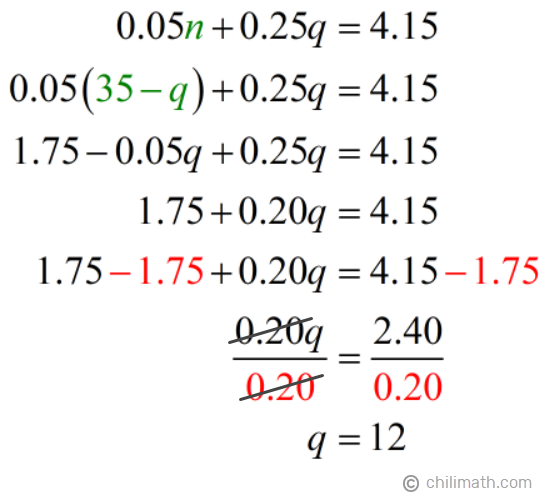
Perfect! This tells us that the number of quarters is 12. Since the problem is asking us to find how many of each coin Tamara has, we will simply subtract 12 from 35 to get the number of nickels.
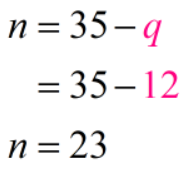
So we have,
- Number of Nickels: 23
- Number of Quarters: 12
Answer: Tamara has 23 nickels and 12 quarters.
Check:
When solving word problems, it’s important to always verify if you got the correct answers. To check, we can plug in the values that we got for [latex]n[/latex] and [latex]q[/latex] into Equation #2 and see if both sides of the equation equal each other.
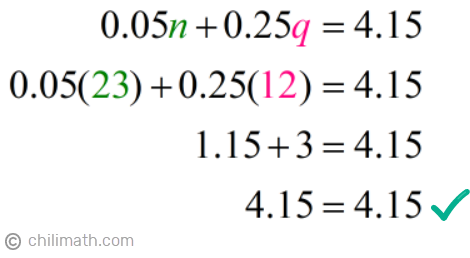
Note that you may also use Equation #1 to check your answers. Like what we just did, you simply have to substitute [latex]n[/latex] and [latex]q[/latex] with 23 and 12, respectively, and see if they equal 35 which is the total number of coins.
Example 2: My brother has been putting only nickels and dimes in his piggy bank. He is able to save up to $3.65. If he has 4 more nickels than dimes, how many of each kind of coin does my brother have?
Let’s start by picking our variables that will stand for the number of each type of coin.
- Let [latex]n[/latex] = number of nickels
- Let [latex]d[/latex] = number of dimes
In this example, we don’t know how many coins there are in total. However, we know that the coins inside the piggy bank only consist of nickels and dimes which amount to $3.65. Translating this into an algebraic equation, we can write this as
Equation #1: [latex]0.05n + 0.10d = 3.65[/latex]
We are also told that there are 4 more nickels than dimes which means that the number of nickels ([latex]n[/latex]) is equal to the number of dimes ([latex]d[/latex]) plus four more.
Equation #2: [latex]n = d+4[/latex]
As you can see in Equation #2, we already have the nickels ([latex]n[/latex]) defined in terms of the dimes ([latex]d[/latex]). In this case, we can go ahead and substitute [latex]n[/latex] with [latex]d + 4[/latex] in Equation #1, then solve for [latex]d[/latex].
Solution:
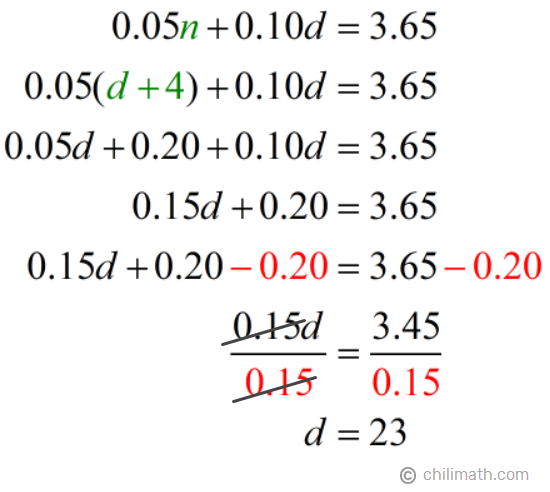
So, this means that there are 23 dimes. Since there are 4 more nickels than dimes, then there must be 27 nickels. We also arrive at the same answer when solving for [latex]n[/latex] using Equation #2.
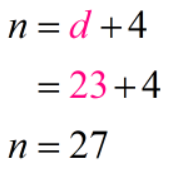
Going back to our original problem, how many of each kind of coin does my brother have?
Answer: My brother has 27 nickels and 23 dimes.
Check:
Let’s plug in the values that we got for [latex]n[/latex] and [latex]d[/latex] into Equation #1 to see if they amount to the total value of the coins which is $3.65.
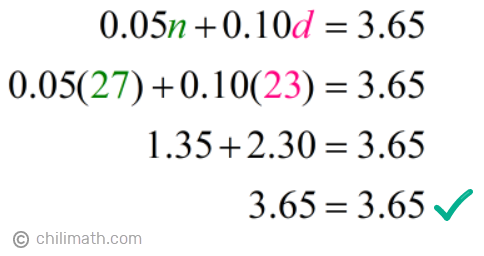
Example 3: A jar of coins has one-third as many dimes as quarters. If the total amount of coins is $5.10, how many dimes and quarters are in the jar?
Before we translate the important statements that are provided in the problem, let’s first select the variables for the unknown values.
- Let [latex]d[/latex] = number of dimes
- Let [latex]q[/latex] = number of quarters
1) A jar of coins has one-third as many dimes as quarters
Equation #1: [latex]\large{d = {1 \over 3}q}[/latex]
2) The total amount of coins is $5.10
Equation #2: [latex]0.10d + 0.25q = 5.10[/latex]
This problem involves a fraction but the setup is the same as our previous example. Again, we are not given the total number of coins, but we are told that the total value of the dimes and quarters is $5.10.
We were already able to define the number of dimes ([latex]d[/latex]) in terms of the number of quarters ([latex]q[/latex]) in Equation #1. So in solving for [latex]q[/latex] using Equation #2, we will simply substitute [latex]d[/latex] with the expression [latex]\large{1 \over 3}q[/latex]
Solution:
![0.10[(1/3)q]+0.25q=5.10 → q=18](https://www.chilimath.com/wp-content/uploads/2020/12/ex3_solution.png)
So there are 18 quarters. Let’s now use this value to find the number of dimes.
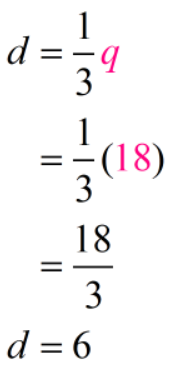
Therefore, we have
- Number of Dimes: 6
- Number of Quarters: 18
Answer: There are 6 dimes and 18 quarters in the jar.
Check:
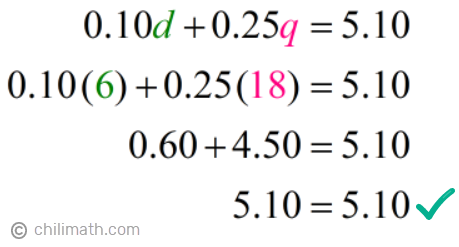
Example 4: Damian had two-thirds as many pennies as nickels. The total value of his coins was $2.38. Find the number he had of each kind of coin.
This problem is quite similar to Example 3 so you should be familiar already with the steps needed to answer this word problem.
- Let [latex]p[/latex] = number of pennies
- Let [latex]n[/latex] = number of nickels
What pieces of information are given to us?
1) Damian had two-thirds as many pennies as nickels.
Equation #1: [latex]\large{p = {2 \over 3}n}[/latex]
2) The total value of his coins was $2.38.
Equation #2: [latex]0.01p + 0.05n = 2.38[/latex]
Let’s now substitute the expression of [latex]p[/latex] in Equation #2 and solve for [latex]n[/latex].
Solution:
![0.01[(2/3)n]+0.15n=2.38 → n=42](https://www.chilimath.com/wp-content/uploads/2020/12/ex4_solution.png)
Now that we know how many nickels there are, let’s move on and find the number of pennies as well.
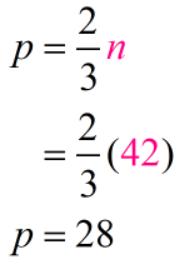
We got the following values:
- Number of Pennies: 28
- Number of Nickels: 42
Answer: Damian had 28 pennies and 42 nickels.
Check:
This time, I’ll leave it up to you to check if both of the values we got for the number of pennies and the number of nickels are correct. You may substitute [latex]p[/latex] and [latex]n[/latex] in Equation #2 with the values and verify if indeed the amount of both coins when added, equals to $2.38.
Example 5: Aunt Sheila has $2.50 in nickels and dimes in her wallet. How many of each kind of coin does she have, if the number of dimes exceeds twice the number of nickels by 5?
We’ll first pick our variables to stand for the nickels and dimes, then examine the important details given to us in the problem.
- Let [latex]n[/latex] = number of nickels
- Let [latex]d[/latex] = number of dimes
Let’s translate each statement algebraically into an equation.
1) Aunt Sheila has $2.50 in nickels and dimes in her wallet.
Equation #1: [latex]0.05n + 0.10d = 2.50[/latex]
2) The number of dimes exceeds twice the number of nickels by 5.
Equation #2: [latex]d=2n+5[/latex]
Since the number of dimes ([latex]d[/latex]) is already expressed in terms of the number of nickels, we can proceed in solving for [latex]n[/latex] using Equation #1.
Solution:
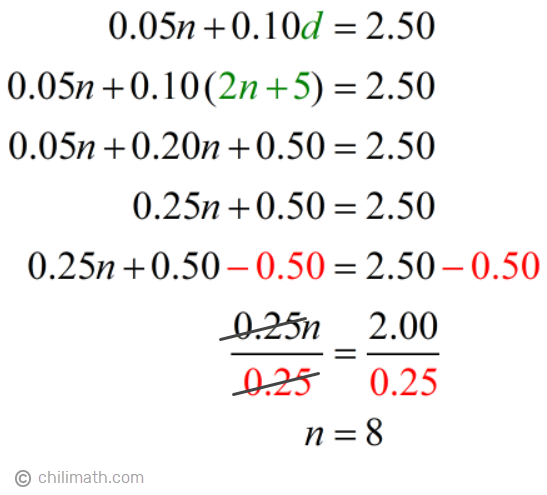
This tells us that there are 8 nickels. Since it says that the number of dimes is 5 more than twice the number of nickels, then let’s use Equation #2 to find how many dimes Aunt Shiela has.
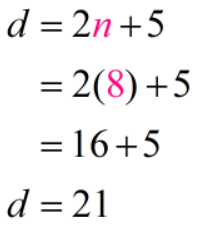
Answer: Aunt Shiela has 8 nickels and 21 dimes.
Check:
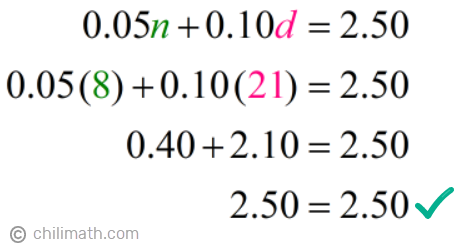
Example 6: I found coins worth $6.97 in my Grandpa’s drawer. Surprisingly, the number of pennies, nickels, dimes, and quarters are all the same. How many of each kind of coin did I find?
This problem is quite unique as it involves not just two but four kinds of coins. Since the quantity for each coin is the same as the other coins, we will select only one variable to stand for each kind. Let’s pick “[latex]c[/latex]”.
- Let [latex]c[/latex] = number of pennies
- Let [latex]c[/latex] = number of nickels
- Let [latex]c[/latex] = number of dimes
- Let [latex]c[/latex] = number of quarters
Now that we have our variable, let’s examine the information given to us closely. We are told that the coins amount to $6.97. Since the quantity for each type of coin ([latex]c[/latex]) is the same as the others, we will multiply the value of each coin in dollars with [latex]c[/latex], add all values of the coins together then set it equal to the total value of all the coins which is $6.97. Therefore, we have
Equation: [latex]0.01c + 0.05c + 0.10c + 0.25c = 6.97[/latex]
We have covered all the important details from our problem in the equation above so we can go ahead and proceed to solve for [latex]c[/latex].
Solution:

Great! We now know that there are 17 coins for each type of coin.
Answer: There are 17 pennies, 17 nickels, 17 dimes, and 17 quarters in my Grandpa’s drawer.
Check:
The last thing that we need to do is to verify that all the coins indeed amount to $6.97.

Example 7: Mrs. Potter received $3.44 of change after paying for her groceries. The cashier gave her a total of 47 coins in pennies, nickels, and dimes. If she received the same number of pennies and nickels, how many of each coin did she receive?
Here we have a coin word problem that is packed with information – which is good! The more details are provided to us, the better. As you can see, we are given the total value of the coins, the total number of coins, and the kinds of coins.
Since Mrs. Potter received the same quantity of pennies and nickels but a different quantity of dimes; we’ll use the variable [latex]c[/latex] to stand for the number of pennies and nickels, and the variable [latex]d[/latex] to represent the number of dimes.
- Let [latex]c[/latex] = number of pennies
- Let [latex]c[/latex] = number of nickels
- Let [latex]d[/latex] = number of dimes
If you haven’t realized it yet, this problem is quite unique just like our previous example. It involves three types of coins but we’re only using two variables to represent them due to the same number of pennies and nickels.
First, we’re told that Mrs. Potter received $3.44 in pennies, nickels, and dimes. To translate this statement into an algebraic equation, it just makes sense to add the values for each type of coin together and then set it equal to $3.44.
Equation #1: [latex]0.01c + 0.05c + 0.10d = 3.44[/latex]
Next, it says that the cashier gave her a total of 47 coins in pennies, nickels, and dimes. This one is easier to translate into an equation since we just have to add the number of pennies, nickels, and dimes on the left-hand side of the equation then set it equal to 47.
Equation #2: [latex]c + c + d = 47[/latex]
At this point, Equation #1 still has two variables. So before we can proceed to find how many of each type of coin she received, we need to express the number of dimes ([latex]d[/latex]) in terms of the number of pennies and nickels ([latex]c[/latex]) first. We can do this by solving for ([latex]d[/latex]) using Equation #2.
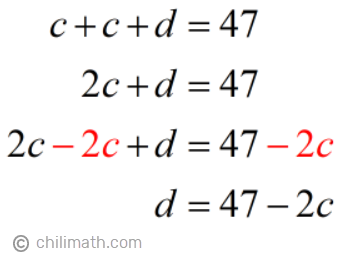
We’ll substitute the value of [latex]d[/latex] with [latex]47 – 2c[/latex] in Equation #1 then solve for [latex]c[/latex]. In doing so, we will only be working with one variable.
Solution:

Perfect! This tells us that there were 9 pennies and 9 nickels. So now, all we have left to do is to find how many dimes there were. We already had the equation for [latex]d[/latex] which is [latex]d = 47 – 2c[/latex]. Using the value we got for [latex]c[/latex], we have
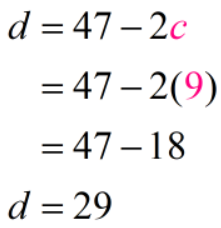
Let’s recap:
- Number of Pennies: 9
- Number of Nickels: 9
- Number of Dimes: 29
Answer: Mrs. Potter received 9 pennies, 9 nickels, and 29 dimes.
Check:
Let’s verify our answers quickly by plugging the values of [latex]c[/latex] and [latex]d[/latex], into Equation #2:
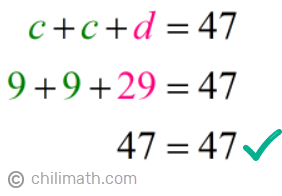
Another option also is to do your check using Equation #1.
Example 8: Mom gave the pizza delivery guy $7.88 in pennies, dimes, and quarters as a tip. She gave him 12 more quarters than pennies and 8 more dimes than quarters. Find the number of each kind of coin that she gave as a tip.
This last example is also an interesting one. Right away, we can see that we are given the total value of the coins and that the tip consists of three types of coins. The quarters are also defined in terms of the pennies while the dimes are described in terms of the quarters.
Just like in our previous examples, let’s start by selecting variables to stand for each type of coin.
- Let [latex]p[/latex] = number of pennies
- Let [latex]d[/latex] = number of dimes
- Let [latex]q[/latex] = number of quarters
Now let’s examine and translate each statement algebraically into an equation that we can solve.
1) Mom gave the pizza delivery guy $7.88 in pennies, dimes, and quarters as a tip.
Equation #1: [latex]0.01p + 0.10d + 0.25q = 7.88[/latex]
2) She gave him 12 more quarters than pennies and 8 more dimes than quarters.
We can translate this statement into two equations to show the number of quarters defined in terms of the number of pennies and the number of dimes defined in terms of the number of quarters.
Equation #2: [latex]q = p + 12[/latex]
Equation #3: [latex]d = q + 8[/latex]
At this time, the pennies are not defined in terms of any of the two coins. But since the dimes are already described in terms of the quarters and the quarters are described in terms of the pennies, it just makes sense for us to describe the number of pennies in terms of the number of quarters as well. We can do this using Equation #2.
[latex]q = p + 12[/latex] → [latex]\color{red}p = q – 12[/latex]
In doing so, both the number of dimes and pennies are defined in terms of [latex]q[/latex] making it possible for us to solve Equation #1 with only one variable. In other words, we will substitute [latex]p[/latex] and [latex]d[/latex] in Equation #1 with their respective algebraic expressions then solve for [latex]q[/latex].
Solution:
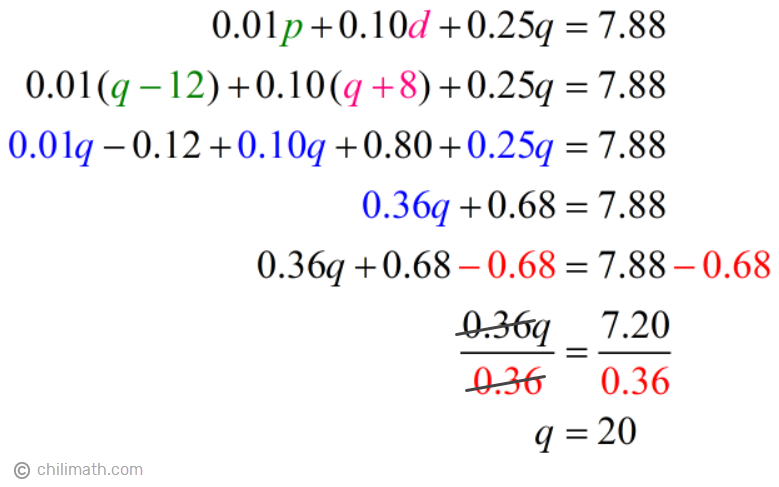
Excellent! This tells us that there were 20 quarters. But since our original problem asks us to find the number for each type of coin, let’s also find out how many pennies and dimes were there, by plugging in the value of the number of quarters into Equation #3 and in the equation for the number of pennies ([latex]p[/latex]).
- Number of Pennies:
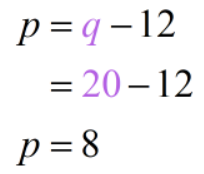
- Number of Dimes:
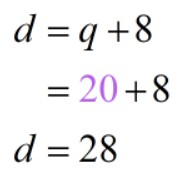
Answer: Mom gave 8 pennies, 28 dimes, and 20 quarters as a tip.
Check:
